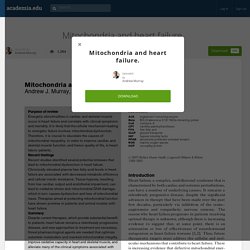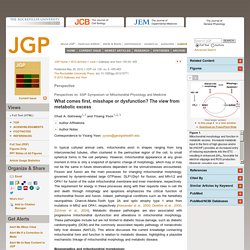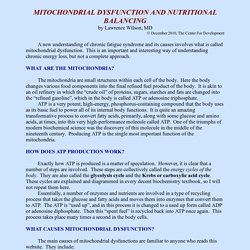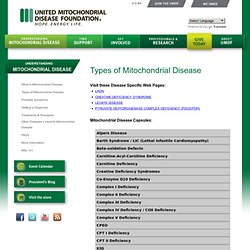

THOMAS SEYFRIED. Forum: General DCA Discussion. Cancer as a metabolic disease. Enfermedades Mitocondriales. | Home | Site Search | Outreach | Ver/Oír Indicio | Primervera 2002 Tabula de ContenidoEnglish version of this article (Versión Inglesa) Extractos reproducidos bajo licencia de United Mitochondrial Disease Foundation, Inc.

Nota de la editora de VER/OÍR: varios niños en Texas que son impedidos visuales o sordociegos tienen, como causa de su pérdida sensorial, enfermedades Mitocondriales. Para entender más acerca de estos padecimientos, visité el sitio web de la United Mitochondrial Disease Foundation. Aprendí que tenemos una magnífica oportunidad en Texas de aprender más sobre estas enfermedades porque su 5ta.
Las enfermedades mitocondriales son resultado de la falla de las mitocondrias, los compartimentos especializados presentes en cada célula del cuerpo, con excepción de los glóbulos rojos de la sangre. No hay una característica única para identificar una enfermedad mitocondrial. Una “enfermedad común” presente características atípicas que la distingan del resto.
Síntomas. Fact Sheet, Mitochondrial Disease & AMDF. Arthritis-2.pdf. Mitochondrial%20dysfunction%20and%20molecular%20pathways%20of%20disease.pdf. Hepatotoxicity due to mitochondrial dysfunction. Mitochondria and heart failure. Copyright © Lippincott Williams & Wilkins.

Unauthorized reproduction of this article is prohibited. SFRR01.pdf. Medscape Log In. What comes first, misshape or dysfunction? The view from metabolic excess. Bioenergetics and mitochondrial morphology Mitochondria are responsible for the bulk of cellular ATP production through oxidative phosphorylation (OXPHOS).

ATP production is driven by the proton motive force, the result of electron transport chain (ETC) components pumping out protons across the inner membrane. The rate of ATP production is greatly dependent on the inner mitochondrial membrane potential (ΔΨm) in coupled respiration. Therefore, strict coupling and maintenance of ΔΨm are necessary for efficient energy production through OXPHOS. Interplay between mitochondrial bioenergetics and morphology has been suspected since observations in the late 1960s by Hackenbrock (1966) noting that coupled ATP synthesis correlated with a condensed internal appearance in isolated mitochondria. Mitochondrial Dysfunction, Nutrition and Aging. By Ward Dean, MD Every cell in the human body is packed with tiny organelles called mitochondria (Fig. 1).

Mitochondria are often referred to as “intracellular powerhouses” because they produce most of the energy used by the body. Cells with a high metabolic rate, such as heart muscle cells, may be equipped with thousands of mitochondria, while other cells may only contain a few dozen. P-E-S-A4805-EN.pdf. Chapter 7 – Mitochondrial Dysfunction, Proteotoxicity, and Aging - Causes or Effects, and the Possible Impact of NAD -Controlled Protein Glycation.
Inflammation (Chronic) - Mitochondrial Dysfunction , Enzymes, Eicosanoids. Of the ten leading causes of mortality in the United States, chronic, low-level inflammation contributes to the pathogenesis of at least seven.

These include heart disease, cancer, chronic lower respiratory disease, stroke, Alzheimer’s disease, diabetes, and nephritis (Centers for Disease Control and Prevention 2011; Bastard et al. 2006; Cao 2011, Jha et al. 2009; Ferrucci et al. 2010; Glorieux et al. 2009; Kundu et al. 2008; Murphy 2012; Singh et al. 2011). Inflammation has classically been viewed as an acute (short term) response to tissue injury that produces characteristic symptoms and usually resolves spontaneously. More contemporary revelations show chronic inflammation to be a major factor in the development of degenerative disease and loss of youthful functions. Untitled. Mitochondria are essential organelles best known for ATP generation and their involvement in apoptosis.

They also play critical roles in other key processes including calcium, copper, and iron homeostasis; heme and iron-sulfur cluster assembly; synthesis of pyrimidines and steroids; thermogenesis and fever response; and calcium signaling. The great majority of the ~1000–1500 (Calvo and Mootha, 2010) proteins that carry out these functions are imported from the cytoplasm via mitochondria targeting sequences or other mechanisms (Bolender et al., 2008), and the proteins present vary significantly with tissue (Johnson et al., 2007).
This variability probably reflects extensive variability in function, ranging from energy production in muscle mitochondria to steroid synthesis in adrenal mitochondria (Vafai and Mootha, 2012). A small number (13 in humans) is encoded in the mitochondrial genome, along with the tRNA and rRNAs required for their synthesis. Fig. 1. Oxidative Stress, Mitochondrial Dysfunction, and Aging. Myths and Facts About Mitochondrial Diseases. Foundation for Mitochondrial Medicine - Supporting Mitochondrial Disease Research and Treatments. Overview of Mitochondrial Disease Mitochondrial disease or dysfunction is an energy production problem.

Almost all cells in the body have mitochondria, which are tiny “power plants” that produce a body’s essential energy. Mitochondrial disease means the power plants in cells don’t function properly. When that happens, some functions in the body don’t work normally. It’s as if the body has a power failure: there is a gradation of effects, like a ‘brown out’ or a ‘black out’. By Lawrence Wilson, MD. By Lawrence Wilson, MD © December 2010, The Center For Development A new understanding of chronic fatigue syndrome and its causes involves what is called mitochondrial dysfunction.

This is an important and interesting way of understanding chronic energy loss, but not a complete approach. The mitochondria are small structures within each cell of the body. Here the body changes various food components into the final refined fuel product of the body. ATP is a very potent, high-energy, phosphorus-containing compound that the body uses as its basic fuel to power all of its internal body functions. Exactly how ATP is produced is a matter of speculation. Essentially, a number of enzymes and nutrients are involved in a type of recycling process that takes the glucose and fatty acids and moves them into enzymes that convert them to ATP. The main causes of mitochondrial dysfunctions are familiar to anyone who reads this website. . · Nutrient deficiencies. Types of Mitochondrial Disease - The United Mitochondrial Disease Foundation. Long Name: Mitochondrial Encephalomyopathy Lactic Acidosis and Strokelike Episodes.
